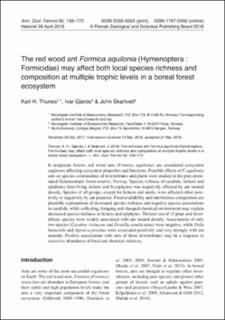| dc.contributor.author | Thunes, Karl H | |
| dc.contributor.author | Gjerde, Ivar | |
| dc.contributor.author | Skartveit, John | |
| dc.date.accessioned | 2021-03-08T09:27:08Z | |
| dc.date.available | 2021-03-08T09:27:08Z | |
| dc.date.created | 2018-04-26T08:52:22Z | |
| dc.date.issued | 2018 | |
| dc.identifier.citation | Annales Zoologici Fennici. 2018, 55 (4-6), 159-172. | en_US |
| dc.identifier.issn | 0003-455X | |
| dc.identifier.uri | https://hdl.handle.net/11250/2732072 | |
| dc.description.abstract | In temperate forests, red wood ants (Formica aquilonia) are considered ecosystem engineers affecting ecosystem properties and functions. Possible effects of F. aquilonia ants on species communities of invertebrates and plants were studied in the pine-dominated Geitaknottane forest reserve, Norway. Species richness of carabids, lichens and epiphytes (tree-living lichens and bryophytes) was negatively affected by ant mound density. Species of all groups, except for lichens and snails, were affected either positively or negatively by ant presence. Food availability and interference competition are plausible explanations of decreased species richness and negative species associations in carabids; while collecting, foraging and changed chemical environment may explain decreased species richness in lichens and epiphytes. Thirteen out of 15 plant and invertebrate species were weakly associated with ant mound density. Associations of only two species (Carabus violaceus and Drusilla canaliculata) were negative, while Pella humeralis and Agroeca proxima were associated positively and very strongly with ant mounds. Positive associations with ants of those invertebrates may be a response to excessive abundance of food and chemical mimicry. | en_US |
| dc.language.iso | eng | en_US |
| dc.relation.uri | http://www.sekj.org/PDF/anzf55OA/anzf55-159-172.pdf | |
| dc.title | The red wood ant Formica aquilonia (Hymenoptera : Formicidae) may affect both local species richness and composition at multiple trophic levels in a boreal forest ecosystem | en_US |
| dc.type | Peer reviewed | en_US |
| dc.type | Journal article | en_US |
| dc.description.version | publishedVersion | en_US |
| dc.source.pagenumber | 159-172 | en_US |
| dc.source.volume | 55 | en_US |
| dc.source.journal | Annales Zoologici Fennici | en_US |
| dc.source.issue | 4-6 | en_US |
| dc.identifier.cristin | 1581719 | |
| cristin.unitcode | 254,0,0,0 | |
| cristin.unitname | NLA Høgskolen | |
| cristin.ispublished | true | |
| cristin.fulltext | original | |
| cristin.qualitycode | 1 | |
